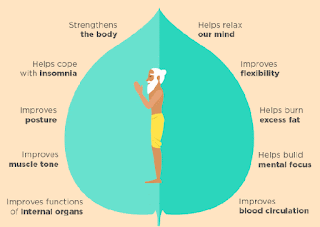Meditation (Dhyana) - An extreme level of Yoga
 |
| Buddha doing Meditation (Dhyana) |
Meditation (Dhyana) - An extreme level of Yoga
After having successfully mastered all the preparatory cleansing, 'asanas' and 'pranayama'; one is ready for 'proper meditation'.
The 'Hatha Yoga Pradipika' text dedicates almost a third of its verses to meditation.
Similarly, other major texts of Hatha yoga such as 'Shiva Samhita' and 'Gheranda Samhita' also discuss meditation.
The ultimate goal of meditation is attaining liberation('moksha'). This is achieved, through the awakening of 'Kundalini' (or seven-chakras of divine energy) that are present in the human body.
'Kundalini', is a form of divine energy (or 'shakti') supposedly located at the base of the spine ('Muladhara'). The term along with practices associated with it was adopted into Hatha yoga in the 11th century and other forms of Hinduism, as well as modern spirituality and new age, though.
But what to meditate upon?
How to awaken 'Kundalini'?
'Kundalini' awakenings are described as happening through a variety of methods including chanting of mantra(like, 'Om Namah Shivaay') beside
meditation, 'asanas', and 'pranayama'.
One needs to focus and meditate upon the focal points of energy in one's body, called 'Chakras'. There are supposedly seven-chakras in our body; awakening/activation of which leads to the awakening of 'kundalini'.
Those seven-chakras are: 'Muladhara' (at the base of spinal cord), 'Swadhishthana'(above Muladhara), 'Manipura' (near stomach region), 'Anahata' (near heart), 'Vishudha' (near throat), 'Ajna' (at centre of forehead or third eye),
'Sahasrara' or the crown chakra (on the top-center of our head).
When awakened, 'Kundalini' is described as rising up from the 'Muladhara' chakra, through the central 'Nadi' (called 'Sushumna') inside or alongside the spine reaching the top of the head activating/awakening each and every chakra coming in its way. The progress of 'Kundalini' through the different chakras is believed to achieve different levels of awakening and mystical experience, until 'Kundalini'
finally reaches the top of the head, 'Sahasrara' or crown chakra, producing an extremely profound transformation of consciousness.
Swami Sivananda Saraswati of the Divine Life Society stated in his book 'Kundalini Yoga' that, "Supersensual visions appear before the mental eye of the aspirant, new worlds with indescribable wonders and charms unfold themselves before the Yogi, planes after planes reveal their existence and grandeur to the practitioner and the Yogi gets divine knowledge, power and bliss, in increasing degrees, when Kundalini passes through Chakra after Chakra, making them bloom in all their glory..."
There are many physical effects taken as signs of a 'Kundalini' awakening, though some consider them as signs rather of 'Chakra' awakening.
The following are either common signs of an awakened 'Kundalini' or symptoms of a problem associated with an awakening Kundalini:
- Enlightenment.
- Bliss, feelings of infinite love and universal connectivity.
- Transcendent awareness, seeing the truth (third eye opening), euphoria.
- Awakened sense of smell, hearing, taste.
- No longer controlled by any kind of desire/cravings.
- The sound heard in the pineal gland (pleasurable/enjoyable).
- Change in the thyroid, sudden ability to sing in perfect pitch, change in voice.
- Change in breathing.
- Energy rushes or feelings of electricity circulating the body. This tingly feeling, at first, might be mistaken for a "shiver."
- Involuntary jerks, tremors, shaking, itching, tingling, and crawling sensations, especially in the arms and legs
- Intense heat (sweating) or cold, especially as energy is experienced passing through the chakras.
- Spontaneous pranayama, asanas, mudras and bandhas.
- Visions or sounds at times associated with a particular chakra.
- Emotional upheavals or surfacing of unwanted and repressed feelings or thoughts with certain repressed emotions becoming dominant in the conscious mind for short or long periods of time.
- Headache,
- Headache, migraine, or pressure inside the skull. Relief of this pressure during an awakening may be felt like a "popping," depending on the person and their body at the time the awakening begins to occur.
- Change in body odor (sweetness/natural/healthy).
- There are ample of information shared by people from all over the world regarding their experiences of 'Kundalini' awakening.
Content source: https://sagesyoga.com/meditation-extreme-level-of-yoga.html


Comments
Post a Comment